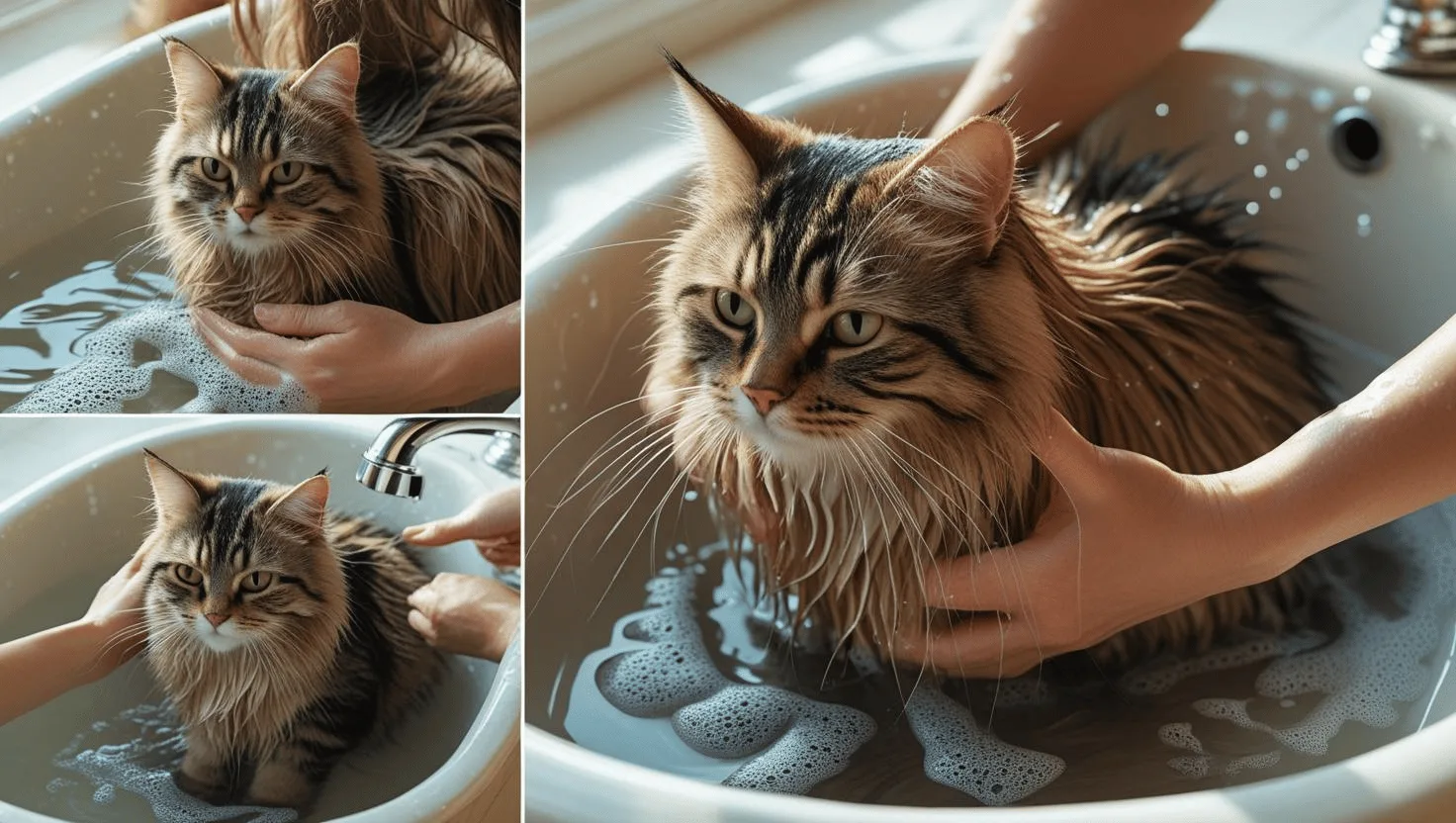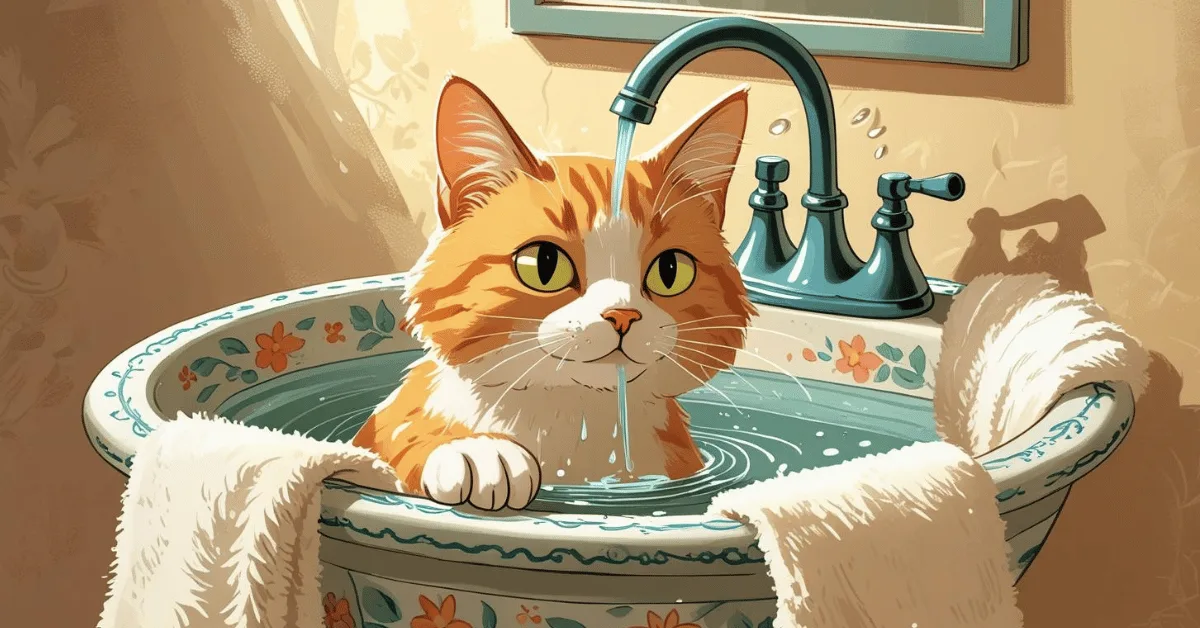For pet parents, this becomes a real challenge when a bath is necessary. Whether your cat rolled in something sticky, developed a flea problem, or needs medicated treatment for a skin condition, sometimes a bath can’t be avoided.
Why Do Cats Hate Water?
Understanding the root of your cat’s dislike for water is the first step toward making bath time easier.
Evolutionary Background
Domestic cats evolved from desert-dwelling ancestors who rarely encountered rivers or lakes. Because they didn’t need water for survival, they never developed the same comfort with it that other animals did. To them, immersion feels foreign and threatening.
Physical and Sensory Discomfort
Water changes how a cat’s fur feels—making it heavy, cold, and slow to dry. This sensation can be deeply unsettling. Cats also dislike unfamiliar textures and smells, and scented shampoos or tap water odors can trigger resistance.
Lack of Control
Cats are naturally cautious and prefer to be in control of their surroundings. Being held in water strips away that control, which can heighten their anxiety and cause panic reactions.
Preparing for the Bath: Setting Yourself Up for Success
A stress-free bath starts with preparation. The more ready you are, the faster and calmer the process will be.
Gather Supplies Beforehand
Never start a cat bath only to realize you forgot the shampoo or towel. Have these ready:
- Cat-specific shampoo (never human or dog shampoo, as it can irritate their skin)
- Pitcher or detachable sprayer for gentle rinsing
- Non-slip mat to prevent slipping in the sink or tub
- Soft towels for drying afterward
- Treats or toys for positive reinforcement
Trim Nails and Brush Fur in Advance
Trim your cat’s nails at least a day before the bath to reduce accidental scratches. Brushing their fur beforehand helps remove tangles and excess shedding, which makes shampooing easier.
Choose the Right Environment
A small bathroom or sink is less intimidating than a big bathtub. Close doors and windows to prevent escapes. Keep the area calm—loud noises or other pets will only increase your cat’s stress.
Related Articles
- Why Do Cats Cry Like Babies at Night?
- Why Your Cat Follows You Everywhere
- Why Does My Cat Scratch the Furniture?
- Why Does My Cat Rub Its Face Against Me?
Step-by-Step Guide: Bathing a Cat That Hates Water

Bathing a water-averse cat is about patience and gentleness. Follow these steps for the best results.
Step 1: Fill With Lukewarm Water
Fill a sink or tub with 2–3 inches of lukewarm water—enough to wet fur but not enough to immerse your cat fully. The temperature should feel warm but not hot, similar to a baby bath.
Step 2: Secure Your Cat Comfortably
Gently place your cat in the water, supporting them under the chest and hindquarters. Keep movements calm and confident. If needed, wrap a towel around the front half of your cat to help them feel more secure.
Step 3: Wet Gradually
Using a cup or sprayer on the lowest setting, wet your cat’s fur slowly from the shoulders down. Avoid the face, ears, and eyes—these should only be cleaned with a damp cloth later.
Step 4: Apply Cat Shampoo
Lather a small amount of shampoo between your hands before applying. Massage it gently into the fur, focusing on soiled or flea-affected areas. Keep motions smooth and reassuring.
Step 5: Rinse Thoroughly
Rinse with lukewarm water until no shampoo residue remains. Leftover soap can irritate skin or cause licking-related stomach issues.
Step 6: Dry With Towels
Wrap your cat in a soft towel immediately and gently pat dry. Avoid vigorous rubbing, which can stress or tangle fur. If your cat tolerates it, you may use a pet-safe blow dryer on a low, quiet setting, but most cats prefer towel-drying.
Pro Tips to Make Bathing Easier
Even with the right steps, cats may resist. Here are extra techniques to reduce struggles.
Use Positive Reinforcement
Reward your cat with treats before, during, and after the bath. This helps them associate bathing with something enjoyable.
Keep Sessions Short
Don’t drag out the process—cats have short tolerance levels. A quick, efficient bath is better than a long, stressful one.
Work With a Helper
If possible, ask a family member to assist. One person can hold the cat securely while the other handles washing.
Alternatives to Traditional Bathing
Sometimes, the best option is avoiding water altogether. Thankfully, there are several alternatives.
Waterless Cat Shampoos
Available in foam or spray form, these products clean fur without rinsing. Simply apply and wipe away with a soft towel.
Grooming Wipes
Cat-safe wipes help remove dirt, dust, and mild odors. They’re perfect for quick cleanups and for cats who won’t tolerate even waterless shampoos.
Professional Grooming
If home bathing feels impossible, professional groomers or veterinarians can safely clean your cat. They have experience handling resistant pets and access to specialized equipment.
When a Cat Bath Is Necessary
Not every cat needs a bath, but in certain cases, skipping it isn’t an option.
Flea or Tick Infestations
Some medicated shampoos are essential for controlling infestations. Always consult your vet for the safest products.
Skin Conditions
Cats with fungal or bacterial skin issues may require prescribed baths. Follow your veterinarian’s instructions carefully.
Sticky or Toxic Substances
If your cat gets into paint, oil, or chemicals, a bath may be necessary for safety. In such cases, contact your vet immediately for advice on safe cleaning.
Handling Aggressive or Anxious Cats

What if your cat becomes aggressive during bath time?
Use Calming Aids
Feline pheromone sprays (like Feliway) or natural calming diffusers can help ease stress before bath time.
Protective Gear
Wearing long sleeves or even light gloves can protect you from scratches without hurting your cat.
Veterinary Assistance
If bathing is impossible without injury, ask your veterinarian about alternatives or mild sedatives for essential medicated baths.
How Often Should You Bathe a Cat?
In most cases, the answer is rarely. Healthy indoor cats do not need regular baths—occasional grooming and brushing are usually enough. Only bathe when:
- Your cat is visibly dirty
- Medical treatment requires it
- Flea/tick infestation demands it
Overbathing can strip natural oils, leading to dry, irritated skin.
Aftercare: Helping Your Cat Recover from the Experience
Create a Cozy Environment
Place your cat in a warm, quiet room after the bath. Provide blankets or a heating pad set on low to speed drying.
Offer Comfort and Treats
Reward your cat with extra attention, food, or play. This helps them forget the stress and rebuild trust.
Monitor for Skin Reactions
Watch for redness, itching, or irritation after the bath. If symptoms appear, consult your veterinarian immediately.
Final Thoughts
Bathing a cat that hates water is never easy, but it doesn’t have to be a traumatic ordeal. With preparation, patience, and the right approach, you can keep your feline clean and safe without unnecessary stress.
If you’re unsure about your cat’s grooming needs, consult your vet. For additional cat-care resources, the American Association of Feline Practitioners provides trusted guidance for pet owners.


1 thought on “How to Bathe a Cat That Hates Water: A Complete Guide for Pet Parents”